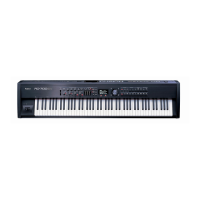92
Making Detailed Settings for Tones
This indicates the tone that is assigned to the zone.
You can select tone using the TONE SELECT buttons.
Sets the volume and the panning (localizes sound image) for
each of the Zones.
The Volume setting is mainly used when multiple tones are
playing to obtain the desired balance in volume between each
zone.
The Pan setting localizes the sound image of each zone when
the output is in stereo. With an increase in the value for L,
more of the sound will be heard as coming from the left side.
Similarly, more of the sound will originate at the right if the
value of R is increased. When set to 0, the sound is heard as
coming from the center.
You can perform with each Zone transposed to a different
pitch.
When multiple tones are playing, you can create a richer
sound by setting the two Tones to different octaves. Also, if the
Keyboard Mode is set to Split (p. 43) and you are playing a
bass Tone in the lower Zone, you can use the Transpose
function to play the bass at a lower pitch.
You can also set the same degree of transposition
for all parts with the [TRANSPOSE] button. For
details, refer to “Transposing the Key of the
Keyboard ([TRANSPOSE] Button)” (p. 47).
When the [SPLIT] button is pressed in normal performance
conditions, the key range is divided at the Split Point, and you
can play with two different tones on one keyboard.
Using Key Range allows you to make even more detailed key
range settings.
This sets the lower and upper limit of the key range in each
part.
After moving the cursor to the parameter to be set, you can
make the setting by pressing the designated key and the
[ENTER] button.
This is effective only when the [SPLIT] button is on
(p. 43) in the key range settings.
“FUL” is displayed when the [SPLIT] button is set to
OFF. In this case, the [SPLIT] button is
automatically switched on when the value is
changed to something other than “FUL” with the
[DEC] [INC] button or VALUE dial.
You cannot set the key range’s lower limit higher
than the upper limit, nor can you set the upper limit
below the lower limit.
When the split point (p. 44) is changed, the Key
Range value also changes.
Selecting the Tone (Tone)
Parameter
Value
TONE
Refer to “Tone List” (p. 189)
Setting the Volume and Pan
(Volume/Pan)
Parameter
Value
VOL (Volume)
0–127
PAN
L64–0–R63
Setting the Transposition for Each
Individual Zone (Transpose)
Parameter
Value
TRA (Transpose)
-48–0–+48
Setting the Key Range for Each Zone
(Key Range)
Parameter
Value
LWR (Key Range Lower)
A0–C8
UPR (Key Range Upper)
NOTE
NOTE
NOTE
RD-700GX_e.book 92 ページ 2008年2月13日 水曜日 午後5時49分

